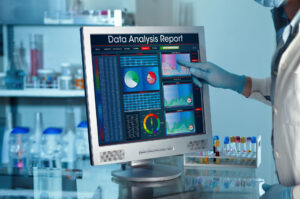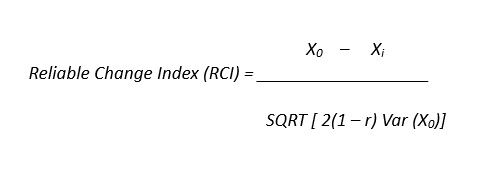Drop Date: August 2025
Better Bioscience: Is It Meaningful?
Rediscovering the ‘Reliable Change Index’
Commentary by Dr. Granger.
 Recently, I took a moment to look in the rear-view mirror and reflect on the evolving role of salivary biomarkers in behavioral research. The view is striking. Over the past 25 years, thousands of published studies have successfully integrated salivary bioscience to gain insights into human physiology and behavior.
Recently, I took a moment to look in the rear-view mirror and reflect on the evolving role of salivary biomarkers in behavioral research. The view is striking. Over the past 25 years, thousands of published studies have successfully integrated salivary bioscience to gain insights into human physiology and behavior.
These advances have been made possible by continuous improvements in methods for saliva collection, handling, transport, storage, and laboratory analysis. Equally important has been the adoption of modern statistical techniques, such as latent state-trait models, dyadic analysis, group-based trajectory modeling, multilevel models, ecological momentary assessment, and social network analysis, which allow us to detect and interpret individual differences in salivary biomarker data with increasing nuance.
Now, the field is entering a new phase: translation. The question is no longer just what salivary biomarkers can tell us at the group level, but how they can inform change and decision-making at the individual level.
The Challenge: What Constitutes a “Meaningful” Change?
The published literature primarily reflects group-level patterns, where small-to-moderate effect sizes are the norm. But those effects are not evenly distributed—some individuals show robust responses, others little to none. As we move toward translational applications, we must ask: How do we define meaningful intra-individual change over time? Can you use what you observed to influence action?
This could involve:
- Pre- and post-event biomarker changes (e.g., acute challenge)
- Baseline to follow-up biomarker changes (e.g., intervention focused on health behavior change)
- Increasing or decreasing biomarker trajectories across days, weeks, or months
In our past work, we approached this issue by defining “meaningful change” as a difference larger than measurement error. We factored in the assay’s technical limits. For example, for salivary cortisol using the Salimetrics assay:
- The smallest difference that can be distinguished from zero, the Lower Limit of Sensitivity (LLS) is ~0.01 µg/dL
- Also, the average technical variation between the same sample repeat tested, the Intra-assay Coefficient of Variation (CV) is ~ 5%
So, we conservatively considered a change to be larger than the technical limits of the assay if it exceeded:
- Absolute value: ≥0.02 µg/dL (2× LLS)
- Relative change: ≥10% (2× average intra-assay CV)
This rule of thumb provided a basic filter to distinguish physiological change from measurement noise.
A New Tactic: Rediscovery of The Reliable Change Index (RCI)
Today, we’d like to introduce a complementary, more advanced tactic with broader potential: the Reliable Change Index (RCI). This metric quantifies whether a change score exceeds what would be expected from measurement error alone, taking into account some additional data-specific parameters, and thus offers an advanced analytical way to determine the significance of individual-level change.
For those interested in the details, the RCI formula is defined below:

Where:
- X0 = Time 1 biomarker level
- Xi = Time 2 biomarker level
- Var(X0) = Variance in the Time 1 biomarker levels within the specific study data set
- r = Reliability coefficient (e.g., Inter class correlation coefficient, ICC, computed from the duplicate tests of the study samples)
The value returned, the RCI, enables an objective, study-specific, threshold for categorizing individuals within a study into:
- Reliable Increase from Time 1 to Time 2
- Reliable Decrease from Time 1 to Time 2
- Or Non-significant fluctuation from Time 1 to Time 2
Points to consider:
- The absolute difference between X0 and Xi will be a function of the effect size you anticipate, combined with individual differences in the participants perceptions and subjective experience.
- The variance in Time 1 levels will decrease as your study sample size increases.
- The ICC will be largest (closer to 1.0) when the laboratory conducting the assays is technically proficient.
- The ICC is also a characteristic based on the performance of the assay that you can use to select one assay protocol over another.
Why This Matters
If you’re working with salivary data, this method could be worth exploring in your own datasets. You might uncover patterns that were previously hidden by group-level averages or arbitrary thresholds. At the very least, it reinforces the importance of:
- Choosing assay protocols carefully
- Trusting the technical qualifications of your laboratory partner
- Thinking critically about what counts as meaningful change
Ultimately, this is where the next wave of translational salivary bioscience is heading: from group trends to personalized, actionable insights. Onward!
If you need more information, Contact Salimetrics. We are a research methods company, and helping researchers do great research matters to us.
REFERENCES & RELATED RESEARCH
- Riis JL, Ahmadi H, Hamilton KR, Bryce CI, Blair C, Granger DA. The case for the repeatability intra-class correlation as a metric of precision for salivary bioscience data: Justification, assessment, application, and implications. Psychoneuroendocrinology. 2021;128:105203. doi:10.1016/j.psyneuen.2021.105203
*Note: Salimetrics provides this information for research use only (RUO). Information is not provided to promote off-label use of medical devices. Please consult the full-text article.
 Contact: Salimetrics (USA)
Contact: Salimetrics (USA)